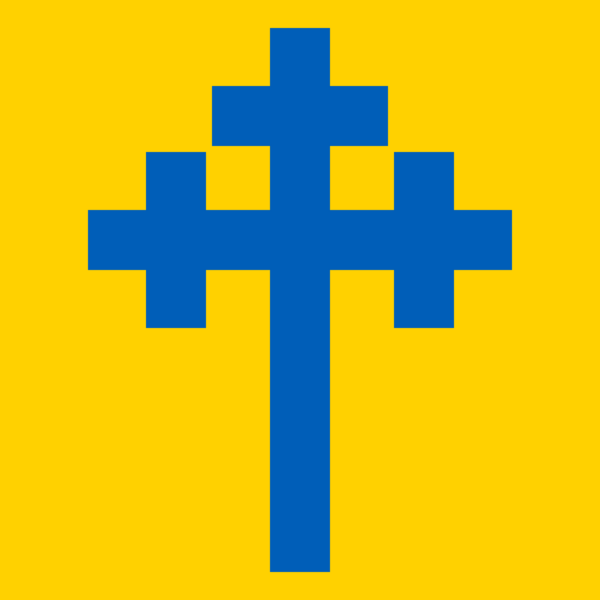Image: Flag of Köping

Description: The banner of arms of the municipality of Köping in Västmanland County, Sweden. According to currently valid heraldic norms and traditions, the proper flag of a Swedish municipality is the so called banner of arms. A banner of arms is essentially a coat of arms in flag form. It must not show the outer shield shape that arms are usually shown with, but it otherwise features the same design, adapted so that the contents satisfyingly fill up the available area. Any contingent accessories around the shield, such as crowns, helmets, or supporters, are left out. The banner of arms stands in contrast to certain incorrect types of flags, such as ones bearing logotypes, or ones displaying the coat of arms as an escutcheon upon a unicoloured background. Such flags are inappropriate from various standpoints, including but not limited to heraldic, graphical, vexillological, and traditionalistic ones. Despite this, some municipalities utilize incorrect flags instead of the correct banner of arms. In Sweden, municipal arms and their corresponding flags represent not only municipal authority, but also municipalities as geographies. The heraldically correct flag of a municipality may be used by the general public to express municipal identity, as long as proper procedures and customs are followed. The person flying the flag does not need acquire permission. The heraldic charge used by Köping hearkens back to the old seal of the city, known from 1349/1378. There, the cross was accompanied by the letter K as a toponymic initial. This emblem has since constituted the heraldic symbol of the city in various settings, such as on banners and standards. However, as letters are seen as contrary to good heraldic practice, the K was omitted when the city of Köping got its arms confirmed by the King in Council on November 8, 1940. When it comes to why the cross was chosen as a symbol in the first place, the municipality puts forward two theories: according to the first, the cross could have to do with the early Christianization of the region, while according to the second, it could stem from the cult of St. Olaf. After the municipal reforms of the 1970s and changes to regulations regarding civic heraldry made during the same period, the arms were registered for Köping Municipality with the Swedish Patent and Registration Office on January 11, 1974, with the following blazon: "In a field of gold a blue, Latin cross with its three upper arms crossed."
Title: Flag of Köping
Credit: Source of this emblazonment: Own work ⸻ General sources about banners of arms and heraldry: Heraldik och statssymboler (in Swedish). Swedish National Archives. Archived from the original on 2022-09-28. Retrieved on 2022-10-01. "Förutom stora och lilla riksvapnet har vi i Sverige vapen för landskap, län, kommuner och stift. Myndigheter och militära enheter har också vapen. Varje vapen kan användas i form av en flagga." Raneke, Jan (1998). "Skåne Halland Blekinge, landskapens vapenbilder" (PDF). Ale: Historisk tidskrift för Skåne, Halland och Blekinge (4): 33. Lund: De skånska landskapens historiska och arkeologiska förening. ISSN 0345-0708. Retrieved on 2022-10-01. "Alla dessa landskaps‐, läns‐ och kommunvapen kan givetvis även användas vid flaggning. En sådan flagga har sköldfältet som flaggduk. Att man, som man gjort på sina håll, använt skölden som centralmotiv på t.ex. vit botten är direkt fel." Vägledning om kommunvapen (in Swedish). Swedish National Archives. Archived from the original on 2022-09-26. Retrieved on 2022-10-01. "Vapnet är också kommunens flagga. En korrekt heraldisk flagga ska vara kvadratisk och dess duk ska ha samma färg, delningar och motiv som vapnet i sköldform. Dessutom ska vapenbilden spegelvändas på dukens motsatta sida så att motivet är rättvänt mot flaggstången. [...] Kommunvapen används emellertid inte endast för att symbolisera kommunen som en myndighet, utan även av andra för att symbolisera kommunens geografiska område – vid nyhetsrapportering, evenemang, på souvenirer och vykort, bildekaler och som privat dekoration. I dessa sammanhang är kommunvapnet fritt för användning. Kommunen ska inte ge tillstånd eftersom det inte behövs. Användaren behöver inte ens fråga om lov. Exempelvis får en privatperson hissa upp en kommunflagga på sin flaggstång. Han riskerar dock att fastigheten av andra blir betraktad som kommunens. Det må betraktas som enbart positivt att en invånare vill ge uttryck för sin kommuntillhörighet genom att använda sig av kommunvapnet – bara det görs på rätt sätt." Andersson, Per (1994) "Inledning" in (in Swedish) Svensk vapenbok för köpingar, municipalsamhällen och landskommuner 1863–1970, Mjölby: Draking, p. 6 ISBN: 91-87784-07-6. OCLC: 470179856. "Mest utmärkande för ett heraldiskt vapen är dess sköldemärke, som oftast ses återgivet i en sköld men som också kan anbringas på andra ytor, t ex en flaggduk, som då helt och hållet fylls ut med sköldemärket." Nevéus, Clara; Bror Jacques de Wærn, ill. (1992) "Heraldik" in (in Swedish) Ny svensk vapenbok, Stockholm: Streiffert, p. 11 ISBN: 91-7886-092-X. "Om vapnet används som flagga vänder vapendjuret nosen mot stången – i varje fall i det fall, då man på klassiskt vis framställt flaggan kvadratisk med flaggduken i fältets färg. (Flaggan bör alltså ha vapenbilden spegelvänd på baksidan!)" "Sveriges symboler" (mobile application). Swedish National Archives. ⸻ Sources about the arms of Köping: Heraldiskt register / vapen (in Swedish). Swedish National Archives. Archived from the original on 2016-03-04. Retrieved on 2022-10-09. Nevéus, Clara; Bror Jacques de Wærn, ill. (1992) "Kommunvapnen" in (in Swedish) Ny svensk vapenbok, Stockholm: Streiffert, p. 94 ISBN: 91-7886-092-X. Scheffer, C.G.U. (1967) "Stadsvapen" in (in Swedish) Svensk vapenbok för landskap, län och städer, Stockholm: Generalstabens litografiska anstalt, p. 43 OCLC: 70322998.
Author: VulpesVulpes42
Usage Terms: Creative Commons Zero, Public Domain Dedication
License: CC0
License Link: http://creativecommons.org/publicdomain/zero/1.0/deed.en
Attribution Required?: No
Image usage
The following page links to this image:

